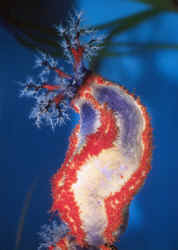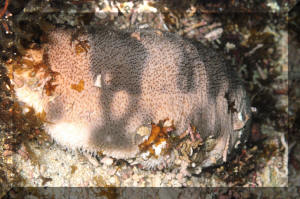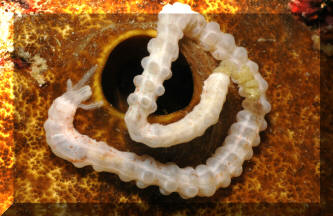|
Related FAQs: Sea Cucumbers, Sea Cucumbers 2,
Cuke IDs, Cuke
Behavior, Cuke Compatibility,
Cuke Selection, Cuke Systems, Cuke Feeding, Cuke Disease, Cuke Reproduction,
Related Articles: Echinoderms, Marine
Scavengers, Sand
Sifters,
Gad-Zooks Cukes!
Sea Cucumbers: Not A
Pretty Picture, Part I
To:
Part 2, Part 3,
Part 4,
|

|
|
By Bob Fenner
|
Paracucumaria tricolor, Pseudocolchirus
violaceus
|
Sea Cucumbers, Class Holothuroidea: With body
shapes ranging from spherical to long and worm-like, bizarre rings of
tentacles circling a non-descript head-end, these slow-moving, drab to
brightly colored and marked invertebrates are well-known at least by
sight, by most aquarists.
Unfortunately they have a dark side. Like many other
spiny-skinned animals, Sea Cucumbers should only be tried in captivity
with knowledge, trepidation and utmost vigil. The reasons for my
cautioning are offered here, as well as notes on general selection and
care for the still curious.
Classification:
Sea Cucumbers make up the Class Holothuroidea of the
"Spiny-skinned-animal" phylum Echinodermata. Other living
Classes comprise the familiar Sea Urchins, Sand Dollars, Sea- and
Brittle Stars and the Crinoids, aka Sea Lilies and Feather Stars.
Holothuroids are the odd-Class out in being secondarily non-radial
appearing; often looking like strange ornamental sausages, some
translucent, others opaque and warty. Cucumber-like!
There are some 900 described species, almost exclusively
marine, distributed worldwide. Sea Cucumbers are a major component of the deep sea fauna. Most are black,
brown or olive in color, but many brilliant colored and patterned
species are encountered. They range in size to barely over an inch (@ 3
cm.) end to end to over a meter in length.
Genus Actinopyga: "Toothed Sea
Cucumbers", named for the series of five teeth ringing their
anus.
| Actinopyga agassizi, the Five-Toothed Sea
Cucumber. Have five square teeth surrounding the anus. Short,
conical podia on back, sides; larger on top. Brown to yellow. |
|
| Actinopyga lecanora Bronn 1860, White-rumped Sea
Cucumber. Light grey or brown, a bit pointed anteriorly. To 300 mm. Spicules
as small rods. Indo-West Pacific. Here in S. Leyte 2013 |

|
| Actinopyga mauritiana (Quoy & Gaimard
1833), the White-Spotted Sea Cucumber, loli (Hawaiian). Frequently
found in surgy, seaward, shallow water settings, holding on firmly
to the rocky substrate with their tube feet. To twelve inches.
Hawai'i pic. |

|
Bigger PIX:
The images in this table are linked
to large (desktop size) copies. Click on "framed" images
to go to the larger size. |
|

|
| Actinopyga obesa (Selenka
1867), the Plump Sea Cucumber, loli (Hawaiian). Reef-associated. To twelve inches.
Hawai'i pic, Kona 2019. |
%20MD.JPG)
|
G enus Astichopus:
| Astichopus multifidus, the Furry Sea Cucumber. White
to light brown bodied Numerous pointed podia, circled in white; short on the
body and skirt around the base. To 16
inches in length. Cozumel 2016 |
%20MD.JPG)
|
Bigger PIX:
The images in this table are linked
to large (desktop size) copies. Click on "framed" images
to go to the larger size. |
|

|
Genus Bohadschia:
| Bohadschia argus Jager 1833, the Ocellated
Sea Cucumber. Western Indian Ocean; Madagascar, Seychelles to Sri
Lanka. Pacific Ocean; Malay Archipelago to South Pacific Islands.
Needs large quarters than captivity allows. To two feet in length.
One in Moorea, French Polynesia, in Fiji and N.
Sulawesi. |
Genus Euapta:
| Euapta godeffroyi
Östergren, 1898. Lions Paw Sea Cucumber.
S. Leyte 2013 |
%20MD.JPG)
|
Bigger PIX:
The images in this table are linked
to large (desktop size) copies. Click on "framed" images
to go to the larger size. |
|
%20MD.JPG)
%20MD.JPG)
|
| Euapta sp. Family Synaptidae. Five
rows of bulbous bumps on cylindrical translucent body. Here on a sponge in
Mabul, Malaysia |

|
To:
Part 2, Part 3,
Part 4,
|
|

